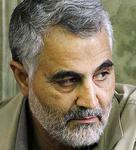Iran’s moment of victory in Tikrit
Joyce Karam/Al Arabiya/Thursday, 12 March 2015
By U.S. Army General Dempsey’s admission, Iran’s proxy Shiite militias make the overwhelming majority of the forces fighting ISIS in the Iraqi town of Tikrit. Out of roughly 25,000 fighters, 20,000 of those, said Dempsey, are from militias funded and trained by Iran, thus highlighting Tehran’s rising influence and dominance in neighboring Iraq.
Tikrit, the birthplace of Saladin the founder of the Ayyubid dynasty in the 12th century and of Iraq’s former dictator Saddam Hussein, is witnessing another chapter in its history unfold. Shiite militias with the Popular Mobilization Forces (Hashd Shaabi) along with one Brigade from the Iraqi forces and a 1000-Sunni-tribal force are poised to push militants from ISIS out of the town it had captured last June.
Iran’s moment
Ever since ISIS took over Mosul declaring its Caliphate last summer, Iran’s role and influence has transformed in Iraq. Its “Dark Night” IRGC General Qassem Suleimani is no longer in the shadows, but posing in battlefront photos assuring fighters from Shiite militias against ISIS, sipping tea, and embracing the elderly in Iraq. Qassem Suleimani’s visibility brings home Iran’s new message: its role and influence in Iraq will no longer be concealed and its ambitious agenda in Sunni and Shiite areas alike is a reality for everyone to reckon with.
Washington’s hands are tied politically and militarily in countering Iranian influence in Iraq
While the invasion in 2003 and the shortsighted policies by the U.S. disbanding the Iraqi army and propping up the sectarian rule of Nouri al-Maliki, opened the door for Iranian meddling and militia-building in Iraq, ISIS has invited a more aggressive role for Iran along the Euphrates.
“Iran has taken full advantage of the collapse of the Iraqi army in Mosul” says Phillip Smyth, a researcher at the University of Maryland and author of a policy paper on Shiite Jihad. The rise of ISIS as an existential threat to Shiites whom it considers heretics and apostates, drove many in that community to carry arms and defend themselves while the Iraqi state continued to crumble. Grand Ayatollah Ali Sistani’s Fatwa last summer “to defend the country, its people, the honor of its citizens, and its sacred places” was exploited to set the stage for the formation of the Popular Mobilization Forces, made up of disciplined Shiite recruits and a much smaller component of Sunni tribal and Kurdish forces.
Smyth sees Iranian influence in funding, training and equipping Shiite militias at an all time high. He estimates the number of Shiite militia fighters in Iraq today between 70,000 100,000, a volume that “is both astounding and strategic to the way that Iran has constructed them.” The expert sees Iran as player whose influence is only rising in Iraq, “they run ministries in Iraq today with their own security apparatus.” This new dynamic was front and center in appointing Mohammad Ghabban from the Iranian funded militia Badr as the new Iraqi interior minister.
U.S. concerned but constrained
In his hearing yesterday, Dempsey voiced concern over the role of Shiite militias in Tikrit battle and in Iraq at large. The U.S. army general told the Senate Foreign Relations Committee: “We are all concerned about what happens after the drums stop beating and ISIS is defeated, and whether the government of Iraq will remain on a path to provide an inclusive government for all of the various groups within it.”
Statements of concern and policy reviews aside, Washington’s hands are tied politically and militarily in countering Iranian influence in Iraq. Smyth explains that the U.S. by eying a “light military footprint in Iraq has set limits on its influence, and has little say of how and who should fight ISIS on the ground.” While the Obama administration is pursuing a parallel structure of Sunni trained “ National Guard” force to take on ISIS, neither the Iraqi government nor these tribes who have visited Washington recently promise a fast execution of such plan anytime soon.
The U.S. increasingly finds its hands tied in Iraq, blindsided by an Iranian-Iraqi offensive in Tikrit and a lame duck government in Baghdad. In this context, the Tikrit battle will “greatly impede U.S. strategy” says Smyth in potentially alienating more Sunnis, and blocking a political path for an inclusive plan to fight ISIS. It was the political marginalization of Sunni Iraqis after all from the beginning of the Iraqi war in 2003 till today that set the stage for the notorious al-Qaeda affiliated groups and then ISIS. Absent of a strategy that addresses this Sunni marginalization and the political malignancy in Iraq, the ISIS phenomenon will unlikely disappear.
For now, Iran’s “Shadow Commander” Suleimani will relish in victorious moments in Tikrit and beyond, only few miles from where his former arch-foe Saddam Hussein is buried and with him the old order of Iraq.




















